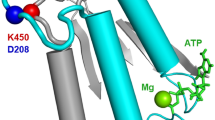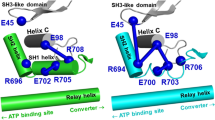Summary
Regulatory light chain (RLC) dissociation from scallop myofibrils, myosin or its subfragments was accompanied by an increase in binding of the hydrophobic fluorophore, 8-anilino-1-naphthalenesulphonate (ANS) to the denuded proteins. The binding was monitored by the large increase in fluorescence emission at 460 nm when excited directly at 380 nm or via energy transfer from nearby tryptophan residues at 295 nm. ANS thus provides a convenient probe for following the kinetics of RLC dissociation in the presence of EDTA and its association in the presence of divalent metal ions. The observed RLC dissociation rate constant for myosin at 20° C was 7.5×10−3 s−1. The association rate constant, which was independent of the RLC concentration, was 5×10−3 s−1. Subfragment 1, prepared by digestion of myosin in the presence of divalent metal ions to protect the light chains [S1(+LC)], showed reversible ANS binding qualitatively similar to the parent molecule. However when prepared in the presence of EDTA, subfragment 1 lacked RLC [S1(−LC)], its heavy chain molecular weight was reduced by about 4000 and it lacked the ANS binding region attributed to the RLC site. The tryptic digestion pattern of S1(+LC) and S1(−LC) suggested that the 4000 difference peptide is at the C-terminus. Tryptic digestion of S1(+LC) has been shown to lead to the production of a regulatory peptide, comprising the two light chains and a heavy chain fragment, which displayed reversible ANS binding on addition of EDTA. Evidence is presented which suggests that this domain is at the C-terminus of subfragment 1.
Similar content being viewed by others
References
BAGSHAW, C. R. (1977) On the location of the divalent metal binding sites and the light chain subunits of vertebrate myosin.Biochemistry 16, 59–67.
BAGSHAW, C. R. (1980) Divalent metal ion binding and subunit interactions in myosins: a critical review.J. Musc. Res. Cell Motility 1, 255–77.
BAGSHAW, C. R. & KENDRICK-JONES, J. (1979) Characterization of homologous divalent metal ion binding sites of vertebrate and molluscan myosins using electron paramagnetic resonance spectroscopy.J. molec. Biol. 130, 317–36.
BAGSHAW, C. R. & KENDRICK-JONES, J. (1980) Identification of the divalent metal ion binding domain of myosin regulatory light chains using spin-labelling techniques.J. molec. Biol. 140, 411–33.
BAGSHAW, C. R., PATEL, N. & WELLS, C. (1982) The kinetics of regulatory light chain binding in scallop myosin.J. Musc. Res. Cell Motility 3, 463.
BAGSHAW, C. R. & REED, G. H. (1977) The significance of the slow dissociation of divalent metal ions from myosin ‘regulatory’ light chains.FEBS Lett. 81, 386–90.
CHANTLER, P. D. & SZENT-GYÖRGYI, A. G. (1980) Regulatory light-chains and scallop myosin: full dissociation, reversibility and cooperative effects.J. molec. Biol. 138, 473–92.
CHEUNG, H. C. & MORALES, M. F. (1969) Studies of myosin conformation by fluorescent techniques.Biochemistry 8, 2177–82.
FLICKER, P. F., WALLIMANN, T. & VIBERT, P. (1983) Electron microscopy of scallop myosin: location of the regulatory light chains.J. molec. Biol. 169, 723–41.
HARDWICKE, P. M. D., WALLIMANN, T. & SZENT-GYÖRGYI, A. G. (1983) Light chain movement and regulation in scallop myosin.Nature 301, 478–82.
KARN, J., McLACHLAN, A. D. & BARNETT, L. (1982)unc-54 Myosin heavy chain gene ofCaenorhabditis elegans: genetics, sequence and structure. InMuscle Development: Molecular and Cellular Control (edited by PEARSON, M. L. and EPSTEIN, H. F.), pp. 129–142. Cold Spring Harbor, New York: Cold Spring Harbor Laboratory.
KENDRICK-JONES, J. & JAKES, R. (1976) Myosin-linked regulation: a chemical approach. InInternational Symposium on Myocardial Failure (edited by RIEKER, G., WEBER, A. and GOODWIN, J.), pp. 28–40. Munich: Tergensee.
KENDRICK-JONES, J., SZENTKIRALYI, E. M. & SZENT-GYÖRGYI, A. G. (1976) Regulatory light chains in myosins.J. molec. Biol. 104, 747–75.
LAEMMLI, U. K. (1970) Cleavage of structural proteins during the assembly of the head of bacteriophage T4.Nature 227, 80–1.
MARGOSSIAN, S. S., LOWEY, S. & BARSHOP, B. (1975) Effect of DTNB light chain on the interaction of vertebrate skeletal myosin with actin.Nature 258, 163–6.
MOSS, R. L., GIULIAN, G. G. & GREASER, M. L. (1982) Physiological effects accompanying the removal of myosin LC2 from skinned skeletal muscle fibers.J. biol. Chem. 257, 8588–94.
MRAKOVČIĆ, A., ODA, S. & REISLER, E. (1979) Salt-induced conformational changes in skeletal myosin light chains, troponin-C and parvalbumin.Biochemistry 18, 5960–5.
SCHOLEY, J. M., TAYLOR, K. A. & KENDRICK-JONES, J. (1981) The role of myosin light chains in regulating actin-myosin interaction.Biochimie 63, 255–71.
SELLERS, J. R., CHANTLER, P. D. & SZENT-GYÖRGYI, A. G. (1980) Hybrid formation between scallop myofibrils and foreign regulatory light-chains.J. molec. Biol. 144, 223–45.
SIMMONS, R. M. & SZENT-GYÖRGYI, A. G. (1978) Reversible loss of calcium control of tension in scallop muscle associated with removal of regulatory light chains.Nature 273, 62–4.
SIVARAMAKRISHNAN, M. & BURKE, M. (1981) Studies on the subunit interactions of skeletal muscle myosin subfragment 1.J. biol. Chem. 256, 2607–10.
SMITH, I. (1953) Color reactions on paper chromatograms by a dipping technique.Nature 171, 43–4.
STAFFORD, W. F., SZENTKIRALYI, E. M. & SZENT-GYÖRGYI, A. G. (1979) Regulatory properties of single-headed fragments of scallop myosin.Biochemistry 24, 5273–80.
STRYER, L. (1965) The interaction of a naphthalene dye with apomyoglobin and apohemoglobin.J. molec. Biol. 13, 482–95.
SZENT-GYÖRGYI, A. G., SZENTKIRALYI, E. M. & KENDRICK-JONES, J. (1973) The light chains of scallop myosin as regulatory subunits.J. molec. Biol. 74, 179–203.
SZENTKIRALY, E. M. (1982) Scallop regulatory and essential light chains complex with the same S-1 heavy chain peptide fragment.Biophys. J. 37, 39a.
SZENTKIRALYI, E. M. (1984) Tryptic digestion of scallop S1: evidence for a complex between the two light-chains and a heavy-chain peptide.J. Musc. Res. Cell Motility 5, 147–64.
VIBERT, P. & CRAIG, R. (1982) Three-dimensional reconstruction of thin filaments decorated with a Ca2+-regulated myosin.J. molec. Biol. 157, 299–319.
WAGNER, P. D. & GINIGER, E. (1981) Hydrolysis of ATP and reversible binding to F-actin by myosin heavy chains free of all light chains.Nature, Lond. 292, 560–2.
WALLIMANN, T., HARDWICKE, P. D. M. & SZENT-GYÖRGYI, A. G. (1982) Regulatory and essential light-chain interactions in scallop myosin.J. molec. Biol. 156, 153–73.
WEEDS, A. G. & POPE, B. (1977) Studies on the chymotryptic digestion of myosin: effects of divalent cations on proteolytic susceptibility.J. molec. Biol. 111, 129–57.
WELLS, C. & BAGSHAW, C. R. (1983) Segmental flexibility and head-head interaction in scallop myosin.J. molec. Biol. 164, 137–57.
Author information
Authors and Affiliations
Rights and permissions
About this article
Cite this article
Bennett, A.J., Patel, N., Wells, C. et al. 8-Anilino-1-naphthalenesulphonate, a fluorescent probe for the regulatory light chain binding site of scallop myosin. J Muscle Res Cell Motil 5, 165–182 (1984). https://doi.org/10.1007/BF00712154
Received:
Revised:
Issue Date:
DOI: https://doi.org/10.1007/BF00712154




